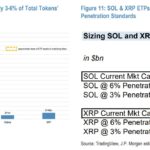A new threat has emerged in the world of cryptocurrency that could put many unsuspecting users at risk. According to a report by CyberArk, a previously unidentified type of cryptojacking malware dubbed “MassJacker” is specifically targeting individuals engaged in software piracy. This malware operates by hijacking crypto transactions and replacing stored wallet addresses with those controlled by cybercriminals.
The MassJacker malware appears to stem from a dubious site known as pesktop[dot]com, where users seeking to download pirated software may inadvertently download this malicious program. Once installed, it can manipulate any crypto addresses stored on the user’s clipboard, directing funds away from their intended recipient and towards the hacker’s wallets. CyberArk’s investigation reveals a staggering 778,531 unique wallets implicated in these operations, although only a fraction—423 wallets—had active cryptocurrency holdings at any point. The total value involved in transactions linked to these wallets has reached approximately 6,700.
Among the breached wallets, one has garnered particular attention, containing over 600 Solana (SOL) with a value nearing ,000, as well as a collection of non-fungible tokens (NFTs) like Gorilla Reborn and Susanoo. This active wallet has a history of 1,184 transactions starting from March 2022, including various decentralized finance activities, demonstrating the sophisticated nature of this cryptojacking scheme.
Crypto malware is not a novel threat; the phenomenon of cryptojacking has been evolving since the first publicly available scripts emerged in 2017. Recent reports indicate that attackers have become adept at hiding their malware in legitimate software development environments, which increases the risks for those downloading applications from unverified sources. For instance, Kaspersky Labs warned that crypto malware has infiltrated app creation kits for popular mobile platforms, capable of targeting users’ seed phrases stored in images.
Additionally, cybersecurity strategies are becoming increasingly sophisticated, with new techniques like the “clipper” attack gaining traction. This method subtly alters cryptocurrency addresses copied to a clipboard without the victim’s knowledge, allowing funds to be rerouted to the attacker—a strategy that often goes undetected.
“Rather than relying on classic phishing tactics, these attackers are adopting more cunning methods, embedding malware during seemingly innocent interactions,” noted a representative from CyberArk.
As the landscape of crypto-security continues to evolve, such threats highlight the importance of vigilance and awareness among users navigating the complex world of digital currencies.
Understanding New Cryptojacking Malware: MassJacker
The emergence of a new type of malware called MassJacker, targeting piracy users and crypto transactions, raises significant concerns for anyone involved in cryptocurrency transactions. Here are key points regarding this threat:
- MassJacker Malware Origin:
- Hosted on pesktop[dot]com, a site for downloading pirated software.
- Users may unknowingly install malware while seeking unauthorized downloads.
- Functionality of MassJacker:
- Replaces crypto addresses in the clipboard with those controlled by attackers.
- This ‘clipper’ attack operates discreetly, often remaining undetected.
- Scale of Impact:
- Linked to 778,531 unique wallets; however, only 423 contained crypto assets.
- Total estimated thefts amount to 6,700, but actual figures may differ.
- Specific High-Value Wallet:
- One particular wallet contained over 600 Solana (approx. ,000) and had multiple transactions.
- Historical activity included swaps of various tokens, indicating ongoing usage.
- Infection Methods are Evolving:
- New strategies include recruiting victims under the guise of job offers.
- Victims are tricked into installing malware while attempting to resolve technical issues.
- Comparison with Other Crypto Malware:
- Unlike prominent ransomware, these attacks are less well-known but increasingly sophisticated.
- Cybersecurity firms have reported similar crypto-stealing malware across various platforms, including mobile and desktop.
This information is crucial for cryptocurrency users as it highlights the need for vigilance when downloading software and securing crypto assets from new sophisticated malware threats.
MassJacker Malware: A New Threat in the Cryptojacking Landscape
The rise of the MassJacker malware, aimed squarely at users engaging in piracy, indicates a significant evolution in the tactics employed by cybercriminals. This new breed of cryptojacking software not only highlights vulnerabilities in the crypto ecosystem but also marks a troubling trend where illegal software downloads lead to financial theft in more sophisticated ways than ever before.
Compared to established forms of malware, such as ransomware and information-stealing applications, MassJacker operates on a relatively discreet level. By targeting clipboard data to replace legitimate crypto transaction addresses with those controlled by the attacker, it flies under the radar of typical cybersecurity protocols. This method of attack, while not widely recognized outside expert circles, presents unique advantages for criminals, particularly given the increasing sophistication of phishing or fake job scams that help deliver the malware undetected. Companies safeguarding digital assets may find their existing security measures are inadequate against this evolving threat.
In terms of competitive advantages, MassJacker stands out due to its specific targeting of piracy users who might be less cautious about installing malware-laden software. This opens up a new avenue for hackers to exploit a demographic that often underestimates cybersecurity risks. While other types of crypto malware have gained attention for stealing from broader user bases, MassJacker’s focus on individuals looking to bypass legal channels means that its potential user base is both smaller and more niche, potentially making it more effective in its specific target audience.
However, the presence of over 778,000 compromised wallets presents a double-edged sword. On one hand, the sheer volume allows for larger-scale exploitation; on the other, it indicates a level of technical complexity that could attract more scrutiny from cybersecurity firms and law enforcement agencies. The light shone on this malware through CyberArk’s reporting could act as a catalyst for more robust defenses against similar attacks in the future.
For crypto traders and users, especially those dabbling in decentralized finance, the emergence of MassJacker poses significant risks. Those who may not fully grasp the nuances of cybersecurity could certainly become victims, leading to financial losses and potential reputational damage. On the flip side, this malware serves as a critical reminder that even simple actions—like pasting a crypto address—can have catastrophic implications in the world of digital finance.
As cybersecurity measures become more advanced and user awareness improves, the lifespan of methods like MassJacker may be limited. Yet, with daily advancements in malware development, what remains clear is that the battle between cyber defenders and attackers is far from over.

















